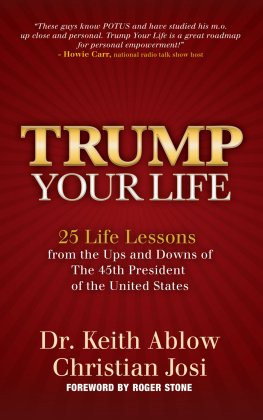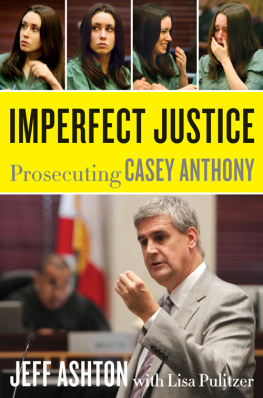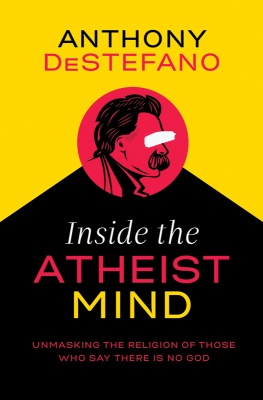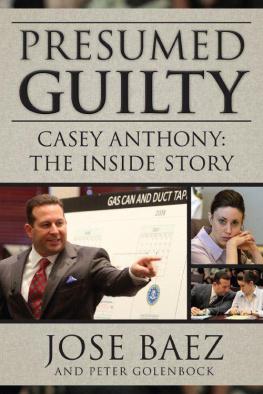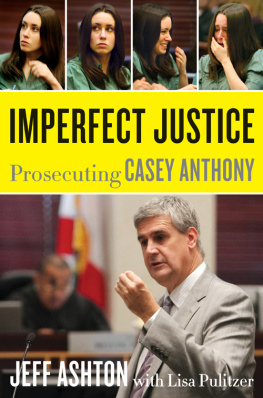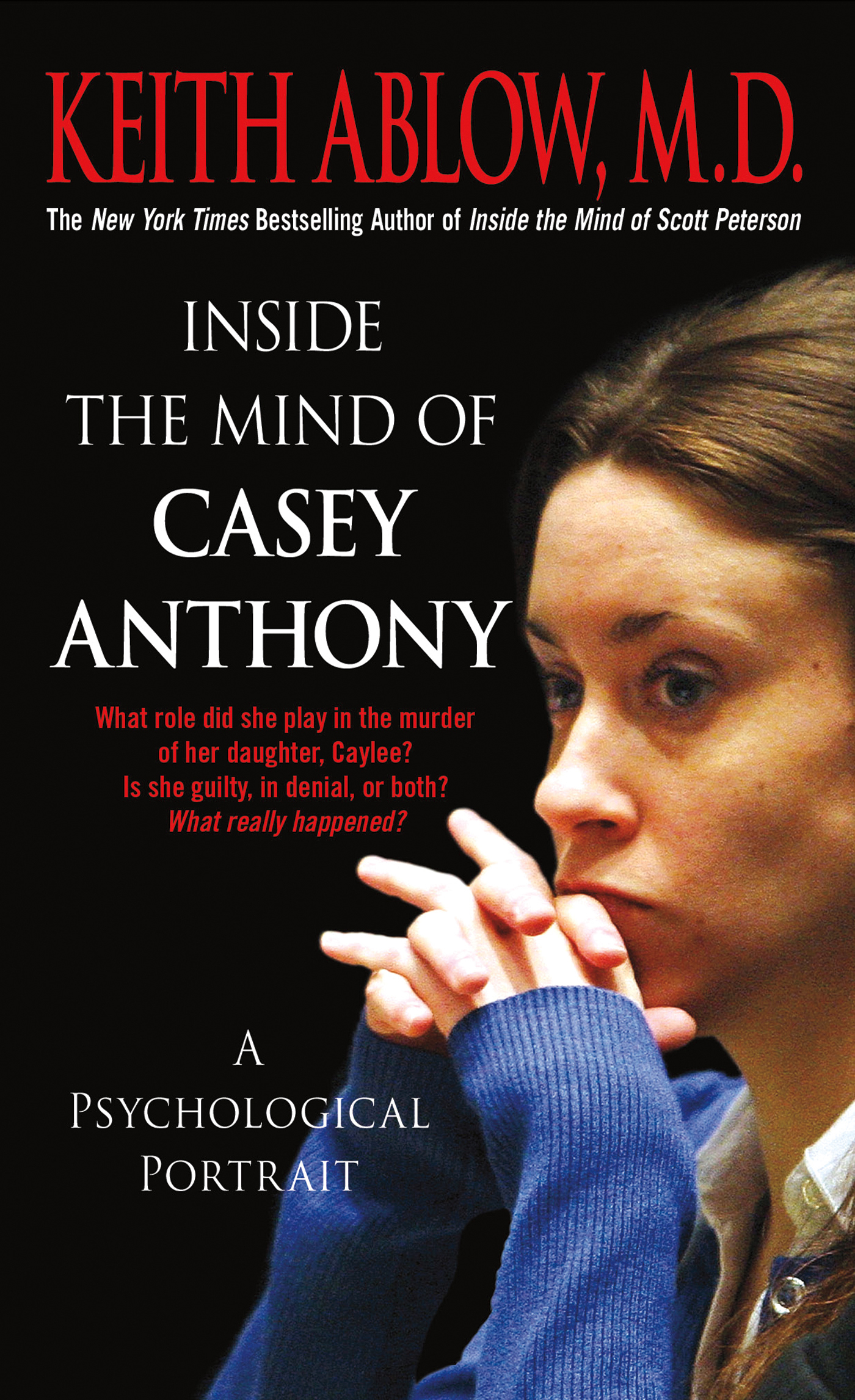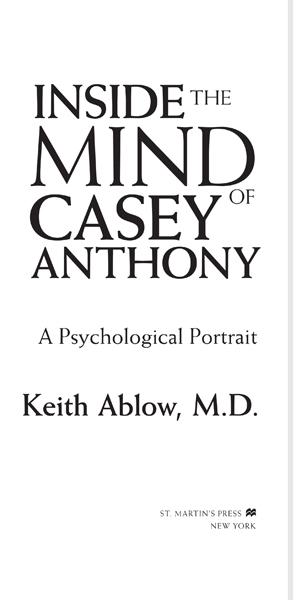
To George Weinberg, PhD, quite possibly Americas greatest living psychologist. Had Casey Anthony met a man such as he, none of this may ever have happened.
Acknowledgments
Amber Roback and Jackie Hodges, my project managers, not only organized the logistics that helped me create this book, but also contributed their own substantial research skills.
Rachel St. Pierre was an effective research assistant, on the ground in Orlando, Florida, and Warren, Ohio.
Bill Shine, senior vice president of programming for the Fox News Channel, as well as Lee Kushnir and Justin Wells of the Fox News Channel, were very helpful to me in gathering or sharing information.
Richard Pine, my literary agent, called me to suggest this book, with the simple statement, Someone needs to explain why this happened. I am in his debt, yet again.
Finally, I thank Sally Richardson, the publisher at St. Martins Press, my editor, Charlie Spicer, and the team working with him. They include John Murphy, Matthew Baldacci, Paul Hochman, Stephanie Hargadon, April Osborn, Eliani Torres, Eric C. Meyer, attorney Mark Lerner, and attorney Diana Frost.
My family awakened too many nights at one and three and five A.M. while I wrote this book, turned on my office light, moved my desk chair a little too noisily over the floor, and hit keys a little too hard on my computer. To them, I officially apologize. This psychological mystery did not let me sleep.
Beneath the water
Im up,
Im down
like a roller coaster
racing through my life
Ive erased the past again
Sevendust, The Past,
Casey Anthonys favorite song
Authors Note
The ideas and psychological theories I express in this book are based on my interviews with my sources in several states, my review of thousands of pages of legal documents and other publications, my review of videotaped testimony, and my many years of experience as a forensic psychiatrist. They are not to be taken as objective fact, but as my perspectives on how to understand the individuals involved and their behaviors. While I repeatedly sought interviews with Casey, George, and Cindy Anthony to further substantiate or refute my ideas, I was consistently refused access to them.
Contents
THE FACTS
On July 15, 2008, Cindy Marie Anthony dialed 911 to report that her granddaughter, Caylee Marie Anthony, a magnificent little girl just shy of her third birthday, was missingand had not been seen for a month.
According to Caylees single mother, twenty-two-year-old Casey Marie Anthony, she had dropped her daughter off at her nannys apartment on June 16. When shed returned there later that day, both the nanny and Caylee had vanished. Casey claimed she had then launched her own monthlong search to no avail.
The police investigation that ensued uncovered the unthinkable: Casey Anthony had invented much of her life story. She had no nanny. She didnt have the job at Universal Studios that she had been telling her parents about for years. She hadnt, as she had told her family, been traveling around the state of Florida with Caylee during the weeks between June 16 and July 15.
Casey Anthony, it turned out, was a kind of ghosta woman with no real identity; no connection to her rageful, shattered inner self; and no person on this earth who really knew the truth about her.
Caylee was dead. She had been placed in a black plastic trash bag and thrown in the woods near the Anthony home at 4937 Hopespring Drive in Orlando, a cruelly ironic address for a house of horror.
SUFFOCATION
The story you are about to read is about suffocationpsychological suffocation leading to physical suffocation, leading to death.
This is a story about how toxic emotional forces in a family, unfolding over decades, slowly extinguished Casey Anthony psychologically, and then suddenly extinguished her two-year-old daughter, Caylee Anthony, physically.
Caylee Anthony was killed by a person who had never lived anything resembling a genuine lifewas never really, truly alive at alland, therefore, assigned no value to a little girls life.
This transmutation of psychological death into physical death usually occurs without anyone taking notice. The victims remains are buried and, with them, the true story of why that person was killed. The people who remain behind escape any postmortem examination. Even if one of them is tried for murder, the truth about the lethal psychological makeup of that person, or those surrounding her, may never be known. That shall not be the case here.
Does the link I suggest between psychological death and physical death surprise you? It shouldnt. One very often causes the other, though it sometimes takes two generations, or three, or even more for it to happen.
Emotional violence snaking its way through a family tree commonly snaps the newest, most innocent, most exquisitely vulnerable limb.
Looking at the corpse of a child, even combing through the physical evidence surrounding her disappearance, cant reveal her real cause of death. Hair samples, DNA, a skull left in the dirt all fail to tell the tale. But a painstaking examination of the psychological dynamics of those closest to her often will.
Few of us would deny that chronic emotional stress can eventually trigger a cardiac arrest, ending a mans life. The stress can act on blood vessels, causing them to clamp down, limiting the oxygen carried to the heart muscle, ultimately destroying that muscle. In some cases, the person doesnt survive.
Well, just as people need oxygen to feed their heart muscle, they need emotional oxygen to feed their souls and sustain that core identity we call the self.
Emotional oxygen is anything that reassures a person that she is a real individual, worthy of being treated as a complete human being. It includes all the times when others react to her behavior with genuine praise, concern, or even justifiable anger. It includes all those times when others honor her thoughts and feelings, listening to them with real attention, responding to them with real intention. In short, it includes all the ways she is affirmed as a person, rather than treated as a nonperson.
Emotional oxygen nurtures a persons developing humanity.
Mental, physical, or sexual abuse can suck all the emotional oxygen out of a home, psychologically suffocating one or more occupants. So, too, can subtle and toxic forms of communication that demand that one or more family members put themselves to sleep or bury themselves alive, suppressing their core identities until they are, for all intents and purposes, nonexistent. It can happen in the dark, under cover of night, as silently as carbon monoxide fills the lungs of children while they sleep.
Without enough emotional oxygen, a person can die spiritually. She can end up despising the truth because she despises the true story of her own psychological destruction. She can become a stranger to her own feelings, then immune to those of others, then hostile to genuine human existence itself. And then sheor, more likely, someone who is dependent on hercan die physically, whether by suicide, murder, or even through carelessness that leads to an avoidable accident.
In short, a family can be so devoid of emotional oxygen that it eventually becomes incompatible with sustaining human life.
The family in which Casey Anthony was raised, into which Caylee Anthony was born, and in which she died before her third birthday, would seem to be such a family.






